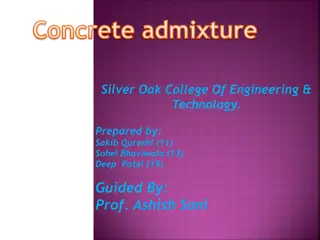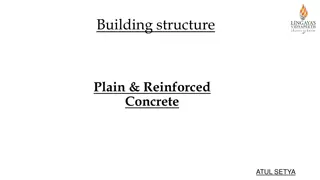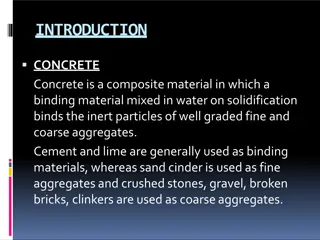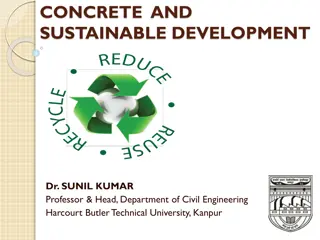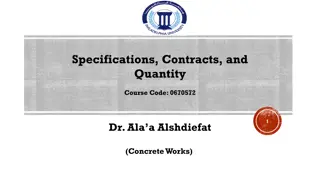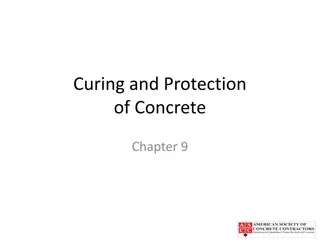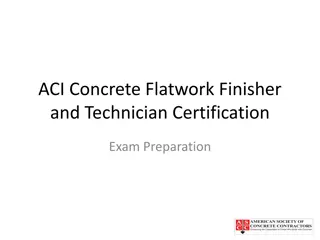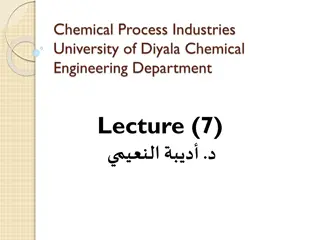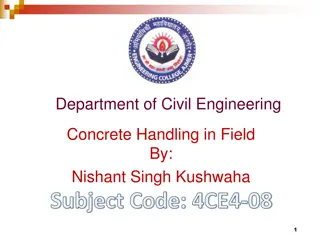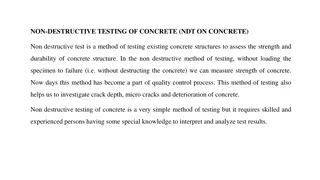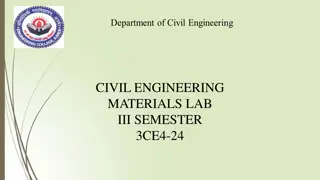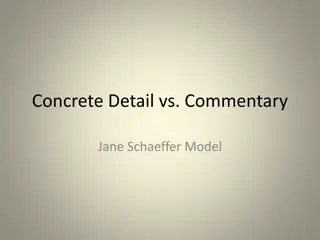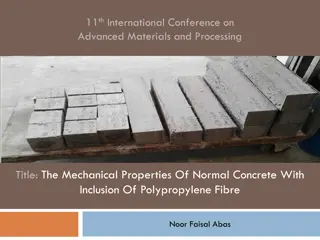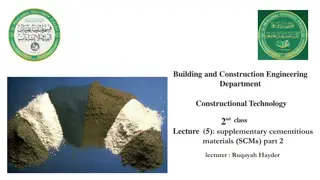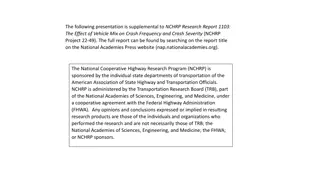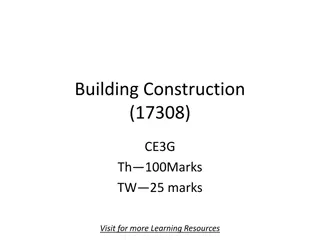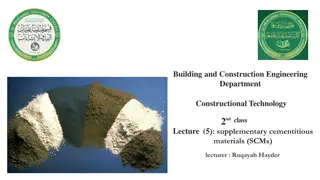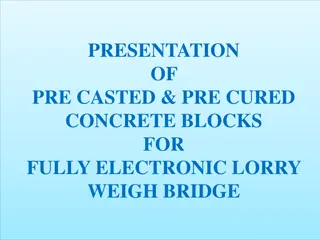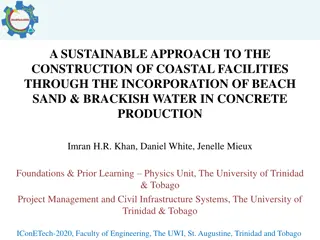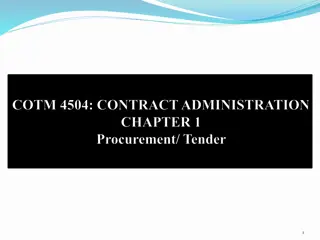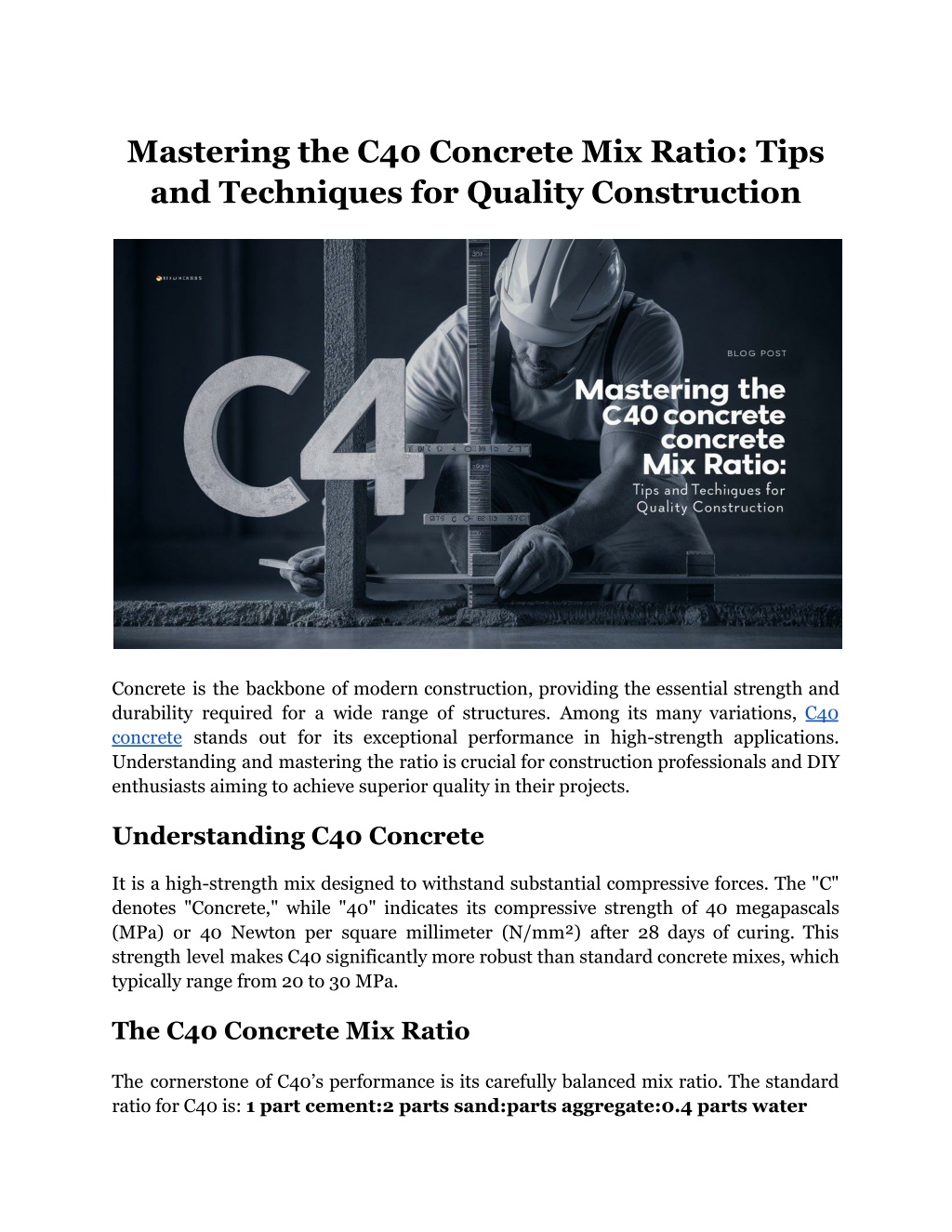
Mastering the C40 Concrete Mix Ratio_ Tips and Techniques for Quality Construction
Learn essential tips and techniques for perfecting the C40 concrete mix ratio. Ensure top-quality construction with our expert guide.
Download Presentation

Please find below an Image/Link to download the presentation.
The content on the website is provided AS IS for your information and personal use only. It may not be sold, licensed, or shared on other websites without obtaining consent from the author. Download presentation by click this link. If you encounter any issues during the download, it is possible that the publisher has removed the file from their server.
E N D
Presentation Transcript
Mastering the C40 Concrete Mix Ratio: Tips and Techniques for Quality Construction Concrete is the backbone of modern construction, providing the essential strength and durability required for a wide range of structures. Among its many variations, C40 concrete stands out for its exceptional performance in high-strength applications. Understanding and mastering the ratio is crucial for construction professionals and DIY enthusiasts aiming to achieve superior quality in their projects. Understanding C40 Concrete It is a high-strength mix designed to withstand substantial compressive forces. The "C" denotes "Concrete," while "40" indicates its compressive strength of 40 megapascals (MPa) or 40 Newton per square millimeter (N/mm ) after 28 days of curing. This strength level makes C40 significantly more robust than standard concrete mixes, which typically range from 20 to 30 MPa. The C40 Concrete Mix Ratio The cornerstone of C40 s performance is its carefully balanced mix ratio. The standard ratio for C40 is: 1 part cement:2 parts sand:parts aggregate:0.4 parts water
This 1:2:3:0.4 ratio is crucial for achieving the desired strength and workability. Let's examine each component in detail: Cement (1 part) For C40 concrete, high-quality Portland cement is essential. The cement acts as the binder, holding all other components together. The type of cement can slightly vary based on specific project requirements, but generally, Ordinary Portland Cement (OPC) of grade 43 or 53 is used. The cement content is typically around 350-400 kg per cubic meter of concrete. Sand (2 parts) The sand serves as the fine aggregate in the mix. It should be clean, well-graded, and free from impurities like clay or organic matter. The ideal sand for C40 has a fineness modulus between 2.3 and 3.1. This helps fill the voids between larger aggregates, improving the concrete's density and strength. Aggregate (3 parts) Coarse aggregates like crushed stone or gravel form the bulk of the concrete mix. For C40, aggregates should be hard, durable, and clean. The maximum size of the aggregate is typically 20mm, though this can vary based on the specific application. Using well-graded aggregates ensures better packing and reduces the amount of cement paste needed to fill voids. Water (0.4 parts) The water-to-cement (w/c) ratio is critical in C40 concrete. At 0.4, it's lower than in standard concrete mixes. This low w/c ratio is key to achieving high strength. It means using 0.4 liters of water for every kilogram of cement. Clean, potable water free from impurities is essential. Read More Articles: How to Achieve the Perfect C40 Mix Ratio for Your Concrete Projects? The Importance of the Water-Cement Ratio in Grade 40 Concrete The 0.4 water-cement ratio in C40 is crucial and deserves special attention. This low ratio achieves several important goals:
High Strength: Less water means fewer pores in the hardened concrete, resulting in higher compressive strength. Improved Durability: A lower w/c ratio creates a denser concrete matrix, making it more resistant to chemical attacks and weathering. Reduced Shrinkage: Less excess water means less shrinkage as the concrete dries, reducing the risk of cracking. Better Workability Control: While a 0.4 w/c ratio produces a relatively stiff mix, it allows for better control of the concrete's workability through the use of admixtures. Mixing C40 Concrete: A Detailed Process Achieving the perfect C40 mix requires precision and attention to detail. Here's an expanded step-by-step guide: Material Preparation Cement: Ensure it's fresh and lump-free. Sand: Screen to remove any large particles or debris. Aggregate: Wash if necessary to remove dust and impurities. Water: Use clean, potable water at the right temperature (typically around 20 C). Precise Measurement For a cubic meter of C40, you might use approximately: 400 kg of cement 800 kg of sand 1200 kg of coarse aggregate 160 liters of water Always measure by weight rather than volume for accuracy. Dry Mixing Mix the dry ingredients (cement, sand, and aggregate) thoroughly. In a mechanical mixer, this usually takes about 1-2 minutes. Ensure even distribution of all components. Water Addition
Add water gradually, not all at once. This allows for better control of the mix consistency. Add about 70% of the water, mix for a minute, then add the remaining water as needed. Wet Mixing Continue mixing for 3-5 minutes after all water is added. The concrete should be uniform in colour and consistency. Be careful not to overmix, as this can lead to segregation. Workability Check Perform a slump test. For C40, a slump of 50-75mm is typical, depending on the specific application. Admixture Incorporation If using admixtures (like superplasticizers), add them at this stage and mix for another 2-3 minutes. Optimising the C40 Concrete Mix To achieve the best results, consider these advanced tips: Aggregate Optimisation Use a mix of aggregate sizes to improve packing density. A combination of 10mm and 20mm aggregates often works well. Superplasticizers These admixtures can help maintain workability even with the low w/c ratio of C40 concrete. They allow you to reduce water content while maintaining flowability. Silica Fume Adding 5-10% silica fume (by weight of cement) can significantly increase strength and durability. It reacts with calcium hydroxide in the cement to form additional binding compounds. Air Entrainment
In freeze-thaw environments, consider using air-entraining admixtures. For C40 concrete, an air content of 4-6% is typically suitable. Temperature Control Monitor and control the temperature of your materials and the mixed concrete. The ideal concrete temperature at placement is between 10 C and 21 C. Quality Control for C40 Concrete Ensuring consistent quality in concrete production requires rigorous testing: Fresh Concrete Tests Slump Test: Aim for a 50-75mm slump for most applications. Air Content Test: Especially important if using air-entraining admixtures. Temperature Measurement: Ensure the concrete is within the ideal temperature range. Hardened Concrete Tests Compressive Strength Test: Conduct at 7 and 28 days. At 28 days, strength should exceed 40 MPa. Permeability Test: Lower permeability indicates better durability. Non-Destructive Tests: Use ultrasonic pulse velocity or rebound hammer tests for in-situ strength estimation. C40 Curing Techniques Proper curing is crucial to reach its full strength potential: Moisture Retention Keep the concrete consistently moist for at least 7 days. Use wet burlap, plastic sheeting, or curing compounds. Temperature Control Maintain temperatures between 10 C and 21 C. In hot weather, consider using ice in the mixed water or applying evaporative cooling. Protection
Shield the concrete from direct sunlight, strong winds, and freezing temperatures. Duration While 7 days is the minimum, extending the curing period to 14 or even 28 days can significantly enhance strength and durability. Read More Articles: Common Mistakes Businesses Make When It Comes To Their Cybersecurity Culture Troubleshooting C40 Concrete Mix Issues Even with careful preparation, issues can arise. Here are some common problems and solutions specific to C40: Low Early Strength Cause: Often due to low curing temperatures or excessive retarder use. Solution: Use heated water in cold weather, consider using accelerators, or increase early-age curing temperature. Excessive Bleeding Cause: Too much water, poor aggregate gradation, or insufficient fines. Solution: Reduce water content, adjust aggregate mix, or consider using a viscosity-modifying admixture. Rapid Slump Loss Cause: High ambient temperature, cement with high C3A content, or insufficient mixing time. Solution: Use retarders, ice in mixed water, or extend the mixing time. Segregation Cause: Excessive vibration, poor aggregate gradation, or too high slump. Solution: Adjust vibration technique, improve aggregate gradation, or reduce water content. Conclusion
Proper preparation, precise mixing, and diligent curing are the keys to achieving a robust and long-lasting concrete structure. As you apply these principles, you'll find that mastering the C40 mix ratio opens the door to creating superior-quality constructions that stand the test of time. When it comes to high-strength and durable concrete for your demanding construction projects, Pro-Mix Concrete offers the perfect C40 concrete mix. Don't leave your project to chance. Ensure the highest quality and performance with Pro-Mix Concrete's C40 mix ratio. Reach out to us today for tailored solutions and professional guidance on your next construction endeavour! Site Article: Mastering the C40 Concrete Mix Ratio: Tips and Techniques for Quality Construction

